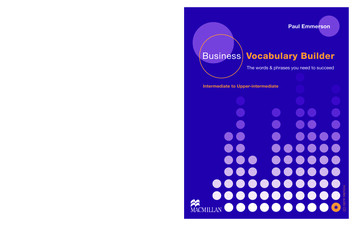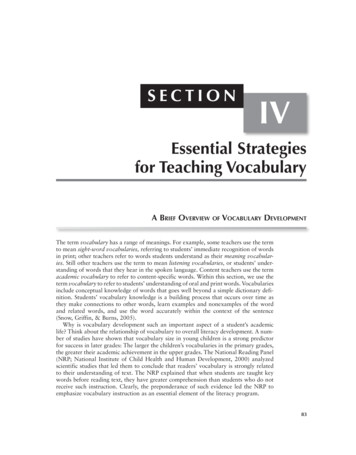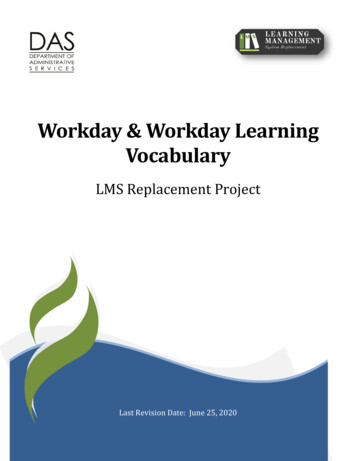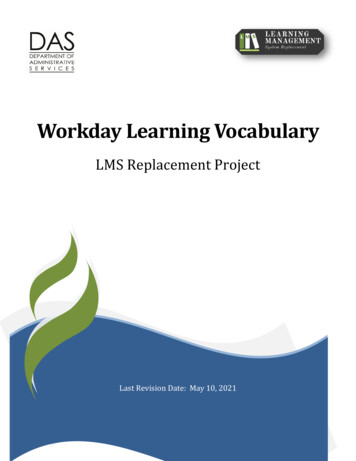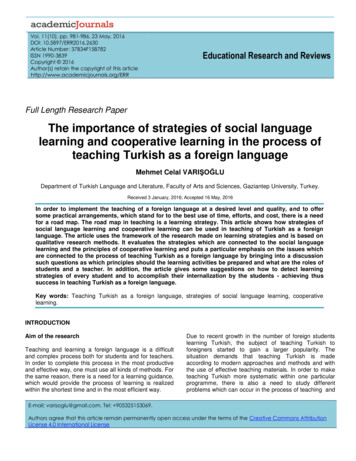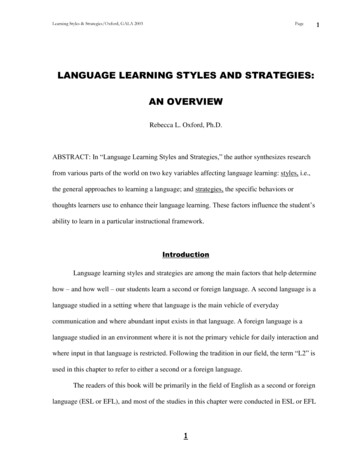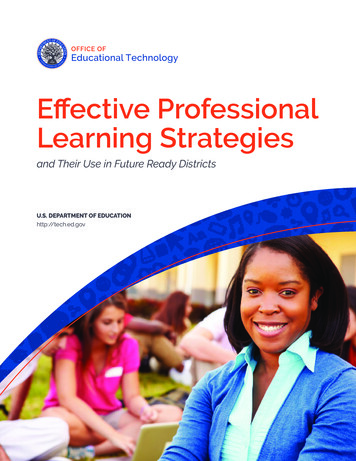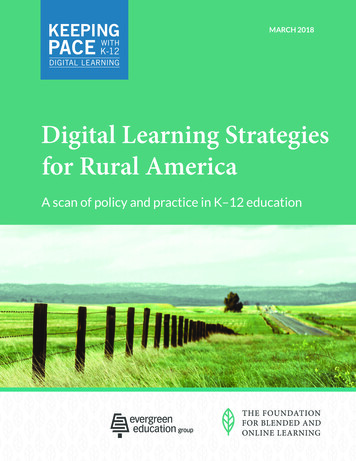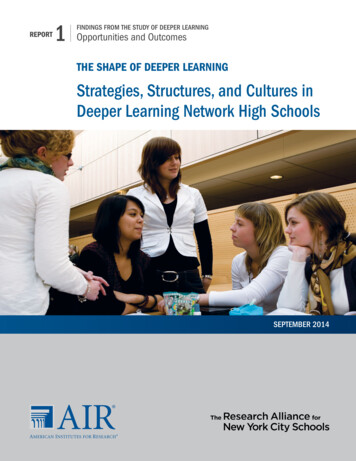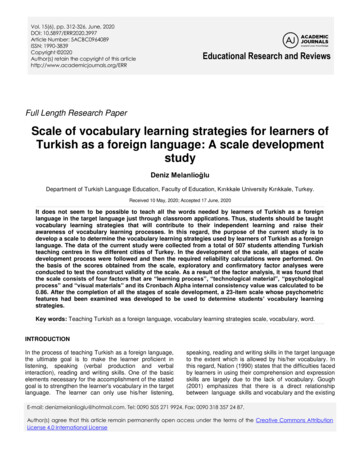
Transcription
Vol. 15(6), pp. 312-326, June, 2020DOI: 10.5897/ERR2020.3997Article Number: 5ACBC0964089ISSN: 1990-3839Copyright 2020Author(s) retain the copyright of this nal Research and ReviewsFull Length Research PaperScale of vocabulary learning strategies for learners ofTurkish as a foreign language: A scale developmentstudyDeniz MelanlioğluDepartment of Turkish Language Education, Faculty of Education, Kırıkkale University Kırıkkale, Turkey.Received 10 May, 2020; Accepted 17 June, 2020It does not seem to be possible to teach all the words needed by learners of Turkish as a foreignlanguage in the target language just through classroom applications. Thus, students should be taughtvocabulary learning strategies that will contribute to their independent learning and raise theirawareness of vocabulary learning processes. In this regard, the purpose of the current study is todevelop a scale to determine the vocabulary learning strategies used by learners of Turkish as a foreignlanguage. The data of the current study were collected from a total of 507 students attending Turkishteaching centres in five different cities of Turkey. In the development of the scale, all stages of scaledevelopment process were followed and then the required reliability calculations were performed. Onthe basis of the scores obtained from the scale, exploratory and confirmatory factor analyses wereconducted to test the construct validity of the scale. As a result of the factor analysis, it was found thatthe scale consists of four factors that are “learning process”, “technological material”, “psychologicalprocess” and “visual materials” and its Cronbach Alpha internal consistency value was calculated to be0.86. After the completion of all the stages of scale development, a 23-item scale whose psychometricfeatures had been examined was developed to be used to determine students’ vocabulary learningstrategies.Key words: Teaching Turkish as a foreign language, vocabulary learning strategies scale, vocabulary, word.INTRODUCTIONIn the process of teaching Turkish as a foreign language,the ultimate goal is to make the learner proficient inlistening, speaking (verbal production and verbalinteraction), reading and writing skills. One of the basicelements necessary for the accomplishment of the statedgoal is to strengthen the learner's vocabulary in the targetlanguage. The learner can only use his/her listening,speaking, reading and writing skills in the target languageto the extent which is allowed by his/her vocabulary. Inthis regard, Nation (1990) states that the difficulties facedby learners in using their comprehension and expressionskills are largely due to the lack of vocabulary. Gough(2001) emphasizes that there is a direct relationshipbetween language skills and vocabulary and the existingE-mail: denizmelanlioglu@hotmail.com. Tel: 0090 505 271 9924. Fax: 0090 318 357 24 87.Author(s) agree that this article remain permanently open access under the terms of the Creative Commons AttributionLicense 4.0 International License
Melanlioğluresearch shows that the vocabulary that the learner hasabout the target language predicts the development oflanguage skills (Meara and Jones, 1987; Karatay, 2007;Özbay and Melanlıoğlu, 2008). Seen from thisperspective, the vocabulary possessed by the learnerdraws the boundaries of his success in language learningas well as the extent to which he/she carries thelanguage he/she has learned to his/her daily life.The vocabulary that can be explained as the sum of thewords in a vocabulary repertoire of a person or a society(Korkmaz, 1992) can be described as a complementaryarea in the teaching of Turkish as a foreign language. Inthis respect, Karadağ (2013) states that the developmentof vocabulary forms the basis for the teaching of alllanguage skills. Skehan (2003) says that the word is thebasis of both language use and language teaching.The vocabulary possessed by a learner consists ofactive and passive vocabulary. While the words definedas active vocabulary refer to the words used by thelearner to produce in writing and speaking, the wordsdefined as passive vocabulary refers to the wordslearned by the learner through reading and listening butnot used. Baş (2006) states that the passive vocabularyis broader than the active vocabulary. The reason for thisis explained by the fact that many words that are notused while talking or writing can be used while listeningor reading. It is necessary to support the student'svocabulary in the target language with words to be usedboth actively and passively.To this end, Karadağ (2013) lists the points to beconsidered in applications to be made for vocabularyteaching:(1) Priority should be given to the most frequently usedwords of the language.(2) Words to be learned by different age groups shouldbe determined.(3) Meaning relations should be established between theknown and newly learned words.(4) The use of the words taught should be ensured.(5) The pronunciation features of words should be takeninto consideration.(6) Spelling of words should be taught.(7) Context-based vocabulary teaching should beperformed.(8) Cognates should be taken into consideration invocabulary teaching.(9) Learners should be encouraged to master vocabularylearning strategies.Considering the listed items, it is understood that it isimportant to teach a word with its all aspects to thelearner and to synthesize the prior information with newinformation while doing this. Existing vocabulary is animportant step in teaching new words. The words thestudent encounters for the first time are stored in memoryby associating them with the known words having close313or similar meanings to these new words (Kurudayıoğlu,2005). Indeed, it is a fact that the most important variableaffecting new learning is prior information. Demirel (2013)states that it is easier for learners to learn words specificto the same concept area. Memiş (2018) states thatproviding students with morphological awareness in thetarget language positively affect their efforts to improvevocabulary. For this reason, vocabulary should be seenas vocabulary units to be learned in a meaningful andcontextual language rather than a long and boring list thatneeds to be defined and memorized (Büyükikiz andHasırcı, 2013). According to Stahl and Nagy (2006), the“importance and benefit” level of words should be takeninto consideration as a general criterion in determiningthe words that should be taught to learners. Aksan (2009)believes that frequency should be used as a criterion inthe selection of words to be taught to learners.Learning a word means an exact match or integrationbetween the word's sensation and meaning (Karadağ,2013). In this sense, the learner is expected to haveknowledge of the word's form (affix-root, pronunciationand spelling), meaning (concept area, connation world,type) and usage (collocation, limitation, grammaticalfunction) (Nation, 1990). One of the difficultiesexperienced by foreign language learners in the processof language learning is to recall the newly learned words.Chang and Millet (2014) state that a word must berepeated 5 to 16 times, and this repetition must besupported by use for this word to stick in the mind of thelearner. Besides repetition, elements such as themeaning of the word in context, the learner's languageability, the methods and techniques used in the process,and the quality of the instructor are also considered to beimportant variables for any word to be permanentlystored in the mind (Hu and Deng, 2007; Kim and Gilman,2008; Brown, 1993). Many new methods and applicationshave been proposed in recent years to developvocabulary in students and it has been emphasized thatthe activities focusing on vocabulary development shouldnot be limited to teaching primary meanings of somecertain words (Çalışkan, 2010; Büyükikiz and Hasırcı,2013; Karadağ, 2013).In the classes where Turkish is taught as a foreignlanguage, the limits of what to give to learners and whatto expect from them in relation to vocabulary teaching aredefined in the European Common Framework as lexical,grammatical, semantical, phonological under the mainheading “Communicative Language Competences” andin the sub-dimension “Grammatical Competences”. Thecontent of the four items listed earlier are directly relatedto vocabulary knowledge.Lexical competence is explained as follows: “It coversthe vocabulary knowledge of a language which consistedof lexical and grammatical elements and the ability ofusing this knowledge” (TELC, 2013). Accordingly, theelements related to vocabulary consist of fixedexpressions which consist of many words and learned
314Educ. Res. Rev.Table 1. Expectations from students of different levels in terms of vocabulary range.C2Has a good command of a very broad lexical repertoire including idiomatic expressions and colloquialisms; shows awareness ofconnotative levels of meaning.C1Has a good command of a broad lexical repertoire allowing gaps to be readily overcome with circumlocutions; little obvioussearching for expressions or avoidance strategies. Good command of idiomatic expressions and colloquialisms.B2Has a good range of vocabulary for matters connected to his/her field and most general topics. Can vary formulation to avoidfrequent repetition, but lexical gaps can still cause hesitation and circumlocution.B1Has a sufficient vocabulary to express him/herself with some circumlocutions on most topics pertinent to his/her everyday lifesuch as family, hobbies and interests, work, travel, and current events.Has sufficient vocabulary to conduct routine, everyday transactions involving familiar situations and topics.A2A1Has sufficient vocabulary for the expression of basic communicative needs.Has a sufficient vocabulary for coping with simple survival needs.Has a basic vocabulary repertoire of isolated words and phrases related to particular concrete situations.Table 2. Competences related to control of vocabulary repertoire.LevelA1A2CompetenceNo descriptor availableCan control a narrow repertoire dealing with concrete everyday needs.B1Shows good control of elementary vocabulary but major errors still occur when expressing more complex thoughts orhandling unfamiliar topics and situations.B2Lexical accuracy is generally high, though some confusion and incorrect word choice does occur without hinderingcommunication.C1C2Occasional minor slips, but no significant vocabulary errors.Consistently correct and appropriate use of vocabulary.and used as whole and simple words. While fixedphrases (Good morning! I am pleased), proverbs, idioms,stereotypical metaphorical expressions, intensifiers, fixedframes, expressions that have fallen out of use constitutesub-steps in the first category, simple words correspondto the words that make sense alone (noun, verb,adjective, adverb, days, months, weight and units ofmeasure) (TELC, 2013).What is expected of the students from different levels interms of vocabulary knowledge in the European CommonFramework of Reference is shown in Table 1 (TELC,2013).As shown in Table 1, competences defined for levelsA1 and A2 are generally related to teaching of the wordsto be needed by students to communicate in their dailylife. From level B2 onwards, it is aimed to teach studentsthe vocabulary needed in their field of expertise as wellas in their daily life. In level C1, the student is expected tohave a rich lexical repertoire that allows him/her tounderstand subtle differences in meaning. In line with thecompetences defined in Table 1, the competencesrelated to the student‟s Control of Vocabulary Repertoiresomehow describing the student‟s world of vocabulary fordifferent levels are also presented. These competencesare shown in Table 2.As can be seen in Table 2, there is no expectation fromthe student in level A1 in terms of controlling his/herpersonal vocabulary. This is largely because of the factthat the student has just been introduced to a newlanguage and the subjects taught in level A1 generallyfocus on the teaching of fixed phrases. B1 is called thethreshold level. Therefore, for this level, the student isexpected to have mastered the basic vocabulary of thetarget language (family relations, numbers, names of
Melanlioğlubody parts, etc). While students are expected to havevocabulary sufficient not to hinder communication in levelB2, they are expected to actively use the words theyhave learned in level C.Aftervocabularycompetence,grammaticalcompetence is defined and within this grammaticalcompetence, issues such as types of words, syntax,phonology and semantics are also discussed. Withinsemantic competence, relationships between words andgeneral context (such as reference, connotation) andinter-lexical relations (synonym, antonym, collocations,etc.) are mentioned. Phonological competence on theother hand involves teaching prosodic features of thetarget language (TELC, 2013). The framework includesgrammatical subjects to improve the student‟svocabulary. When the four sub-dimensions ofgrammatical competence are considered, it is understoodthat teaching a word with its all aspects is prioritized inresearch on vocabulary.The Common European Framework of Reference doesnot specify which words should be taught in each level byproviding vocabulary lists. Yet, it suggests that thefollowing points should be taken into consideration in theselection of the words to be taught:(1) Words required for students to achievecommunicative tasks.(2) Words that comply with the language learningobjective of the target group.(3) Words that are most frequently used in daily life in thetarget language.(4) Words repeated in the texts encountered by thestudent (TELC, 2013).In addition to these suggestions, the framework answersthe question “How the vocabulary of language learnersshould be developed?(1) Through direct exposure to the words and fixedidioms used in daily life conversation texts and writtentexts(2) By lo
Scale of vocabulary learning strategies for learners of Turkish as a foreign language: A scale development study Deniz Melanlioğlu Department of Turkish Language Education, Faculty of Education, Kırıkkale University Kırıkkale, Turkey. Received 10 May, 2020; Accepted 17 June, 2020 It does not seem to be possible to teach all the words needed by learners of Turkish as a foreign language in .
